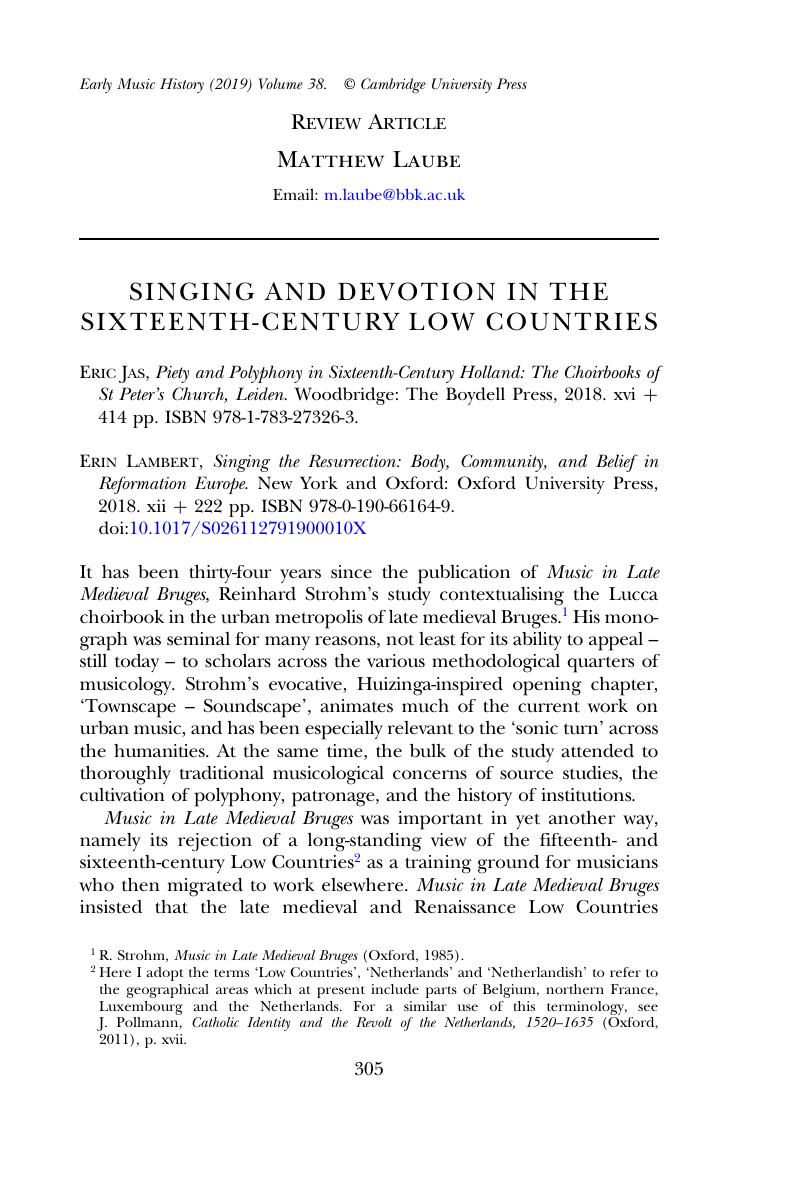No CrossRef data available.
Article contents
SINGING AND DEVOTION IN THE SIXTEENTH-CENTURY LOW COUNTRIES
Review products
Published online by Cambridge University Press: 11 September 2019
Abstract

- Type
- Review Article
- Information
- Copyright
- © Cambridge University Press 2019
References
1 Strohm, R., Music in Late Medieval Bruges (Oxford, 1985).Google Scholar
2 Here I adopt the terms ‘Low Countries’, ‘Netherlands’ and ‘Netherlandish’ to refer to the geographical areas which at present include parts of Belgium, northern France, Luxembourg and the Netherlands. For a similar use of this terminology, see Pollmann, J., Catholic Identity and the Revolt of the Netherlands, 1520–1635 (Oxford, 2011), p. xvii.CrossRefGoogle Scholar
3 Strohm, Late Medieval Bruges, pp. v and 2.
4 Dillon, E., The Sense of Sound: Musical Meaning in France, 1260–1330 (New York, 2012).Google Scholar
5 Pollmann, Catholic Identity, ch. 1.
6 de Ridder-Symoens, H., ‘Education and Literacy in the Burgundian-Hapsburg Netherlands’, Canadian Journal of Netherlandic Studies, 16/1, (1995), pp. 6–21.Google Scholar
7 Arnade, P., Realms of Ritual: Burgundian Ceremony and Civic Life in Late Medieval Ghent (Ithaca, NY, 1996), p. 56.Google Scholar
8 Kroniek eener kloosterzuster van het voormalig Bossche klooster ‘Marienburg’ over de troebelen te ’s-Hertogenbosch in de jaren 1566–76, ed. H. van Alf (’s-Hertogenbosch, 1931), p. 2.
9 Brandt, G., The History of the Reformation and other Ecclesiastical Transactions in and about the Low Countries, i (London, 1720), p. 203.Google Scholar
10 Ibid., p. 193.
11 Crew, P., Calvinist Preaching and Iconoclasm in the Netherlands, 1544–1569 (Cambridge, 1978), p. 23.Google Scholar
12 Freedberg, D., ‘Art and Iconoclasm, 1525–1580: The Case of the Northern Netherlands’, in Filedt Kok, J. P., Halsema-Kubes, W. and Th. Kloek, W. (eds.), Kunst voor de Beeldenstorm (Amsterdam, 1986), p. 73.Google Scholar
13 Relations politiques des Pays-Bas et de L’Angleterre sous le règne de Philippe II, iv, ed. J. M. B. C. Kervyn de Lettenhove (Brussels, 1885), p. 338.
14 For a parallel argument about iconoclasts’ physical reaction to sacrament houses, see van Bruaene, A., ‘Embodied Piety: Sacrament Houses and Iconoclasm in the Sixteenth-Century Low Countries’, BMGN – Low Countries Historical Review, 131/1 (2016), pp. 36–58.CrossRefGoogle Scholar
15 Steen, C., The Time of Troubles in the Low Countries: The Chronicles and Memoirs of Pasquier de le Barre of Tournai, 1559–1567 (New York, 1989), p. 56.Google Scholar
16 For precise numbers of Anabaptists prosecuted in Leiden, see Geraerts, J., ‘The Prosecution of Anabaptists in Holland, 1530–66’, Mennonite Quarterly Review, 86 (2012), pp. 5–48.Google Scholar
17 Trocmé-Latter, D., The Singing of the Strasbourg Protestants, 1523–1541 (Farnham, 2015)Google Scholar; Leaver, R., The Whole Church Sings: Congregational Singing in Luther’s Wittenberg (Grand Rapids, MI, 2017).Google Scholar
18 For instance, Walsham, Alexandra, Providence in Early Modern England (Oxford, 1999).Google Scholar
19 Strohm, Late Medieval Bruges, p. 3.
20 Arnold, J., ‘Catholic Reformations: A Medieval Perspective’, in Bamji, A., Janssen, G. H., and Laven, M. (eds.), The Ashgate Research Companion to the Counter-Reformation(Farnham, 2013), p. 420.Google Scholar
21 Rosser, G., Medieval Westminster: 1200–1540 (Oxford, 1989), p. 3.Google Scholar
22 Champion, M., The Fullness of Time: Temporalities of the Fifteenth-Century Low Countries (Chicago, 2017).CrossRefGoogle Scholar
23 On the social dynamics of the mining community in Mansfeld, see Roper, L., Martin Luther: Renegade and Prophet (London, 2016), pp. 17–34.Google Scholar



